The Venus Cult

Eve. Cult of the Mother Goddess. Andites.
It
was during this age in Crete that the mother cult of the
descendants of Cain
attained its greatest vogue. This cult glorified Eve in the worship of the "great mother."
UrantiaBook 895
They became mother worshipers as the result of the work of missionaries from Crete.
These tribes later amalgamated with groups of Andonite sailors who came by boats
from the coast of Asia Minor, and who were also mother worshipers.
Much of central Europe was thus early settled by these mixed types
of the broad-headed white races which practiced mother worship
and the religious rite of cremating the dead,
for it was the custom of the mother cultists to burn their dead in stone huts.
Urantia Book 897

Dolmen, stone hut, Zennor Cornwall England
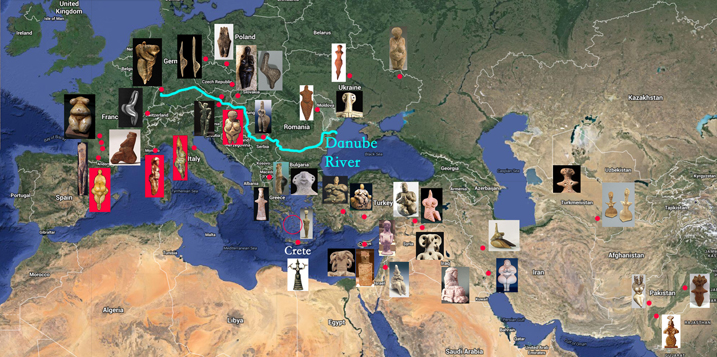
attained its greatest vogue. This cult glorified Eve in the worship of the "great mother."
UrantiaBook 895
They became mother worshipers as the result of the work of missionaries from Crete.
These tribes later amalgamated with groups of Andonite sailors who came by boats
from the coast of Asia Minor, and who were also mother worshipers.
Much of central Europe was thus early settled by these mixed types
of the broad-headed white races which practiced mother worship
and the religious rite of cremating the dead,
for it was the custom of the mother cultists to burn their dead in stone huts.
Urantia Book 897

Dolmen, stone hut, Zennor Cornwall England

 This statuette is considered as the first Upper Paleolithic Venus figurine
ever to be
discovered and it was found in France. Named the Venus
Impudique (Immodest Venus also an immature and chaste female or a young
girl) by the Marquis Paul de Vibraye who found this
figurine
in 1864 at Laugerie-Basse in the Vezere valley Dordogne. It is
carved
from mammoth ivory tusk. The name
Venus stuck as a term to describe these small hand
held statuettes.
It dates to about 14000 BC near the end of the Paleolithic the
Old Stone Age.
This statuette is considered as the first Upper Paleolithic Venus figurine
ever to be
discovered and it was found in France. Named the Venus
Impudique (Immodest Venus also an immature and chaste female or a young
girl) by the Marquis Paul de Vibraye who found this
figurine
in 1864 at Laugerie-Basse in the Vezere valley Dordogne. It is
carved
from mammoth ivory tusk. The name
Venus stuck as a term to describe these small hand
held statuettes.
It dates to about 14000 BC near the end of the Paleolithic the
Old Stone Age. 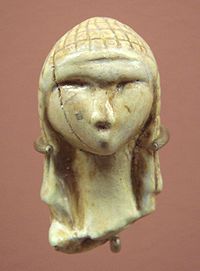
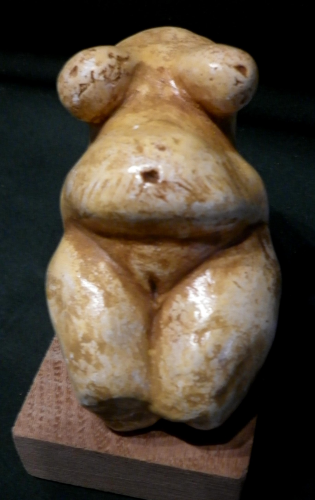 In 1892
the Venus of Brassempouy was discovered by Édouard Piette.
About
25000 years old, it is one of the earliest known realistic
representation of a human face. A second discovery by Piette is this
reconstructed torso of the Venus of La Poire. With these three
figurines the Venus name for such small carved figures was becoming the
accepted
identity. It was finally established for these Paleolithic figures with
the
naming of the Venus of Willendorf. The newest archaeologists are
tending away from the term goddess to a more neutral politically
correct term of "female
figurine." But the public's desire to continue to call these "idol"
figurines as "Venuses" and "mother earth goddesses" has not diminished.
In 1892
the Venus of Brassempouy was discovered by Édouard Piette.
About
25000 years old, it is one of the earliest known realistic
representation of a human face. A second discovery by Piette is this
reconstructed torso of the Venus of La Poire. With these three
figurines the Venus name for such small carved figures was becoming the
accepted
identity. It was finally established for these Paleolithic figures with
the
naming of the Venus of Willendorf. The newest archaeologists are
tending away from the term goddess to a more neutral politically
correct term of "female
figurine." But the public's desire to continue to call these "idol"
figurines as "Venuses" and "mother earth goddesses" has not diminished.
"We need a name for the female icons; they are the primary human image in early archaeology. The term “female figurines,” while nakedly descriptive, is an inadequate designation for a cultural phenomenon that is so widespread, so central, in the iconography of archaic cultures."
" 'Idol' is loaded with pejorative connotations, remnants of the culture-wars against pagans. “Fertility idol” is offensively reductive. As Paula Gunn Allen says of the Laguna creator Thought Woman: “to assign to this great being the position of ‘fertility goddess’ is exceedingly demeaning; it trivializes the tribes and it trivializes the power of woman.” [Allen 1986: 14]"
(http://www.academia.edu/9974324/Icons_of_the_Matrix_female_symbolism_in_ancient_culture_2014_update)
The
Aurignacian Venus
36000-27000 BC
Earliest Figurines
36000-27000 BC
Earliest Figurines


 Venus
of Hohle Fels 36000-31000 BC is
Venus
of Hohle Fels 36000-31000 BC isalso called the Venus of Schelklingen, Germany.
It is the oldest of all the Venus figurines and the earliest undisputed example of figurative art known to archaeology. Discovered in 2008 it is the forerunner in style to later Ice Age art which includes exaggerated breasts and genitals, diminutive hands and feet with etched lines about the torso. It is carved from mammoth ivory tusk. This particular figurine was used as a pendant as you can see by the photo the loop for the attachment of string. A very unusual detail for such an early date.
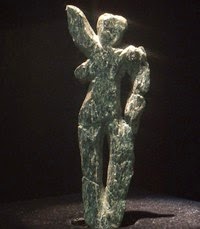 Venus
of Galgenberg 28000 BC Austria
Venus
of Galgenberg 28000 BC AustriaFound in 1988 it is carved in a stone called serpentine. This figurine was located near the later discovery of the Venus of Willendorf and at its time of discovery was the oldest stone sculpture. Serpentine is one of the materials used for axes. There is not much information published about this green colored figurine.
I am not convinced that the Venus figures of the Aurignacian are true Venus figures although they certainly could be given Venus figurines date from the time of the Garden of Eden. And it was at the very beginning of its existence that Cain had his misfortunes but also his blessings. If these figurines are true Venus figures, the embodiment of Eve, then they would be Adamic and that is possible as well but in my opinion not probable. The Urantia Book makes no mention that the migrations of the earliest Adamites carried these figurines with them. But it does say that there is a connection through Cain's descendants on Crete. More information on Eve/Cain can be found on my page Enoch.
The bench mark for all of this is the date for the establishment of the second Garden which is 36000 BC. This is also the date for when Cain left for the Land of Nod. It is at the start of the Aurignacian during which these first figurines were carved. It does seem like a strange coincidence which is what I believe but there is that very slim possibility the Hohle Fels figurine is the genuine thing. But it is my opinion that true Venus figurines have an Andite origin and it would be another 10000 years before the Andites began to appear much less migrate. The Aurignacian flows seamlessly into the Gravettian at about 27000 BC. The Urantia Book has the first appearing Andites at 25000 BC and the archaeological date for the earliest figurine is set at 23000 BC for the Gravettian era.
 "At
twenty-five thousand years ago many of the of the purer elements of the
Adamites were well on their northern trek." (UB 870)
"At
twenty-five thousand years ago many of the of the purer elements of the
Adamites were well on their northern trek." (UB 870)That northern trek would be the migration into Turkmenistan. It was a trail that had been earlier blazed by Adamson in his quest for Van's easternmost headquarters. As the Adamites slowly advanced into Eurasia they branched out across central Asia advancing to the north and then back west travelling about the Caspian Sea.
"At the period of early Adamic migrations ended, about 15,000 B.C., there were already more descendants of Adam in Europe and central Asia than anywhere else in the world, even than in Mesopotamia." (UB 871)
These Adamic people venturing into Europe were not pure Adamite but mixed with the other races, particularly the Nodites. By this time the Danubian route had been known for thousands of years. Some Historians push the Aurignacian as far back as 50000 years to Paleolithic settlements in Bulgaria.
"The Aurignacian culture, characterized by its distinctive style of stone tools, first appeared in Europe in Bulgaria perhaps 50,000 years ago. Evidence suggests that these people moved up the Danube to Hungary then west to Austria. They also spread south from Austria into northern Italy and then rapidly westward along the Mediterranean coast, across the Pyrenees, and finally reaching the Portuguese Atlantic coast by 38,000 years ago. There is no clearly dated archaeological source for Aurignacian tools outside of Europe before 47,000 years ago; however the Belgian archaeologist Marcel Otte has identified the Zagros Mountains in Iran and Iraq as a the (sic) likely origin of this culture."
(http://www.humanjourney.us/europe2.html)

The map above show the boundries of Aurignacian culture and is a composit of several maps I have seen and what I have read. I have included Sicily as it was attached to Italy at this time, an additional area of the Ukraine and I extended southwards to the mountains of the Zagros. It is larger than most maps but I think it is fairly accurate. All maps on the Aurignacian are guesses. No one really can say for sure what the boundries actually are. If this culture started in the Zagros then it had to have swept across Mesopotamia, then Anatolia into the Slavic countries and followed the Danube into western Europe. That would be the general route. The Hohle Fels pendant (36000-31000 BC) was found at the western terminus of the Danube which is in the Black Forest. These people of course were not agriculturists but hunters and gathers. Neanderthal was hunting in this area of western Europe having come by the same route that the later migrations of Andites from the Russian Steppes and Turkmenistan would use. The land mass for this culture was very large but the population would have been small, just an association of tribes of evolutionary man.
The Gravettian
Venus
27000 - 20000 BC
Use of Red Ochre
27000 - 20000 BC
Use of Red Ochre
Its age makes this Venus the oldest ceramic sculpture in the world predating the use of fired clay to make pottery. Today the earliest date of fired pottery is from China some 18000 years ago. Discovered in 1925 radiocarbon dating on the human remains at this location date to approximately 27000 years ago. Upon close examination a child's fingerprint was found imprinted into the clay before it was fired.
 Venus
of La Poire 25000 BC Brassempouy France
Venus
of La Poire 25000 BC Brassempouy FranceThis is a reconstruction of the fairly fractured original. Discovered in 1892 it is carved from mammoth ivory. There is a long ribbon of small etched marks which have been interpreted as tattoos on the side of this figurine. I think that this speculation is most likely correct. Similiar tattoos have been found on some ancient mummies.
 Venus of
Lespugue 25-21000 BC
France
Venus of
Lespugue 25-21000 BC
FranceThe Venus of Lespugue was found in 1922 in the Rideaux cave of Lespugue (Haute-Garonne) in the foothills of the Pyrenees. It is carved from a fragment of mammoth ivory tusk, of which some of the front portion has been restored in this image. This figurine was covered with red ochre. Upper Paleolithic female figures such as this one are found from the Pyrenees mountains to Siberia, indicating that East and West were once united in honoring the Goddess. The vast majority (over 90%) of human images from 30000 to 5000 b.c. are female. Note the hands to the breasts which even at this early date is classic Venus.
 Venus of Savignano 24000 BC Italy
Venus of Savignano 24000 BC ItalyFound in 1925 at Savignano sul Punarom near Modena it was found in alluvial deposits devoid of any archaeological context and therefore dating is uncertain. It has traces of red ochre indicating a symbolic use.
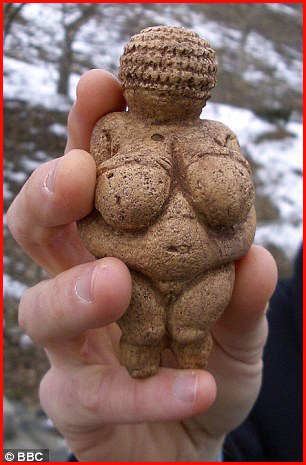 Venus
of Willendorf 24-22000
BC
Vienna Austria
Venus
of Willendorf 24-22000
BC
Vienna Austria The Venus of Willendorf was covered with a thick layer of red ochre when found which was mistakenly removed during the cleaning process. This most famous Venus was discovered in 1908 at a Paleolithic site in Lower Austria and is carved from oolitic limestone which is not native to this location. Chistopher Witcombe makes a reference to this figurine as "acquiring an Ur-Eve identity" which is the only mention I have seen concerning any connection to Eve.
(https://www.asu.edu/cfa/wwwcourses/art/SOACore/Willendorf_portfolio.htm)
 Venus of
Balzi Rossi about 23000 BC Border of Italy and France
Venus of
Balzi Rossi about 23000 BC Border of Italy and FranceCommonly referred to as the Red Ochre Lady this figurine was found in the vicinity among fifteen others but has not officially been dated. Due to other figurines found at this location which closely resemble the Venus of Willendorf I have dated it to 23000 BC. It would be the forth Venus that had been covered in red ochre which would also put it in this time frame. The closest date I have found is "about 20000 years ago."
 The Kostenki
Venus 23000 BC Siberia Russia
The Kostenki
Venus 23000 BC Siberia RussiaMade of limestone this figurine resembles the Venus of Willendorf with similar treatment to the head and general characteristics. It has indications of clothing and most importantly the head decoration which could be a woven hat or shell-hat. Shell-hats have been found in other locations as grave artifacts.

My
map extends to Russia and includes Kostenki, some maps stop at the
Czech
Republic. If anything this map could be larger to include more of
eastern Europe. The figures shown at Kostenki have similar
characteristics to
the Venus of Willendorf and the Venus of Lespugue. That
indicates that the Venuses of Kostenki are firmly related to the more
western group. The figurines with the red background are those found
with evidence of red ochre. The dates are too close together to
determine the direction of flow of influence but most likely would be
quickly east to
west and without the aid of the horse. The
horse was domesticated about 10000 years ago or 8000 BC in the Eurasian
Steppes. It would be the Andites that tamed that horse Equus ferus.
The Magdalénien Venus
15000 - 10000 BC
Stylistic Abstraction
 Venus of Courbet 13000 BC
Bruniquel France
Venus of Courbet 13000 BC
Bruniquel FranceFound in 1864 it is made from fine-grained red quartzite. As with some of the other figurines some of the cave's artifacts included bone needles even at times bone whistles. One cave had a bone pipe.
 Venus
of Pekárna 13000 BC Moravia (Gimbutas: Old Europe)
Venus
of Pekárna 13000 BC Moravia (Gimbutas: Old Europe)Made of mammoth ivory tusk it was discovered in 1927. Other photos of this figurine are up side down from this one. This image is from the Anthropos, Moravské Zemské Muzeum, Brno in Moravia. Judging from other similar Venus figurines they got it right.
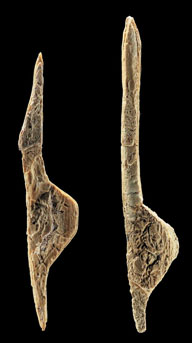
 The
Nebra Venus 12-11000 BC Germany (also
Gönnersdorf)
The
Nebra Venus 12-11000 BC Germany (also
Gönnersdorf)These are highly stylized statuettes dating from the late Upper Paleolithic and are the oldest known works of art in Saxony-Anhalt. They were discovered in 1962. Made of reindeer antler which helps define its shape the Nebra figurines are another example of abstraction of female representation.
 If
you are really into the prehistoric the photo to the left is the Nebra
Sky Disk which is about 3600 years old and was used as an astronomical
device.
If
you are really into the prehistoric the photo to the left is the Nebra
Sky Disk which is about 3600 years old and was used as an astronomical
device. Venus
of Neuchâtel-Monruz 11000 BC
Switzerland
Venus
of Neuchâtel-Monruz 11000 BC
SwitzerlandA pendant Venus in the minimalist style of the Nebra and Pekárna tradition. Carved from jet a hard coal that is easily worked and polished. The Venus of Engen and the Venus of Petersfels from Germany are almost identical in shape made of jet and also have the drilled through hole. These figurines are sometimes referred to as silhouettes. Could have been an item of trade.

As
you can see the styles are closely related. At least two are in a
sitting position with the Pekárna as
undecided but probably could be
included. The Venus of Courbet is carved from a red granite which seems
to continue the red ochre tradition of the Venus from the Gravettian.
These new highly stylized Venuses are stripped down to the briefest
essentials. I have more to say on this subject in the conclusion
paragraph.
Neolithic - HistoricMore Natural Figures, Stylized Plank Figurines and Civilization
 Sha'ar HaGolan 8000 BC Israel
Sha'ar HaGolan 8000 BC IsraelThis Neolithic site is the most important and largest in Israel. Most of the other figurines are not as detailed as this one. Partially excavated from 1948 to 1962 with new excavations starting since 1989. The Venus is made of clay and is assembled of various parts.


 Çatalhöyük figures 7500 BC
Anatolia South Central
Turkey
Çatalhöyük figures 7500 BC
Anatolia South Central
TurkeyTwo different styles from this early settlement. The figure seated on a throne clearly defines her as a goddess while the more stick-figure like statuette demonstrates an evolving style of being more abstract. It is not unusual to see a mix of styles within cultural artifacts. There are other figurines found at this site that are painted in the Halaf style. Female figurines are found at all levels of the site and after level VI they increase in number and become more finely modeled. The third figure made of fired clay is incorrectly identified on the internet as being from Göbekli Tepe.
 Hacilar 7000 BC Antolia South Western Turkey
Hacilar 7000 BC Antolia South Western TurkeyCalled a Mother Goddess and made of clay. It has been noted that the continuation at Hacilar of the goddess figurine tradition advanced westward from Çatalhöyük. I have seen dates as early as 8500 BC for this figure but no dates that early for Çatalhöyük. And since Hacilar is dated after Çatalhöyük the 8500 date has to be in error. Some Archaeologists date Çatalhöyük to only 6500 and that would be a 1000 year difference from its accepted date of 7500 which makes 6500 unsustainable. This figure also is a variance on the sitting goddess position.
 Tumba
Venus 58-5300 BC Skopje, Macedonia (Gimbutas: Old Europe)
Tumba
Venus 58-5300 BC Skopje, Macedonia (Gimbutas: Old Europe)The figurines from Macedonia vary greatly with representations of almost all styles. This one has the steatopygous hips which most Venus figurines have. Found in 1989 it is carved from marble of a dark and light gray color. Other figurines are deeply incised like those of the Cucuteni-Trypillian culture. Macedonia was one of the crossroads during the Neolithic and easily reached from Anatolia, Turkey. This location seems a melding pot of many characteristics.
 Starcevo
Venus 55-4500 BC Serbia (Gimbutas: Old Europe)
Starcevo
Venus 55-4500 BC Serbia (Gimbutas: Old Europe)These cultural figurines have very heavy thighs as their main feature much like the Tumba Venus above. The style variance is small from what I have seen. Since Starcevo is a Danubian location I was surprised in not seeing a wider range of styles. The head and neck are fused as a single cylindrical shape and in some of the figurines the face disappeared altogether thus presenting a more phallic looking appearance.

 Halaf Venus 5000 BC northern Syrian
border of Mesopotamia
Halaf Venus 5000 BC northern Syrian
border of MesopotamiaOne of several styles the seated goddess. The majority are painted in this stripped fashion. One theory of why the seated posture has been explained in relation to childbirth. I think it is ultimately Mesopotamian in tradition in that it is one of the attributes of Inanna seated on her throne, which does occur in many other figures.

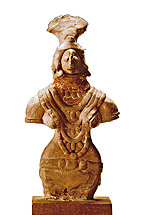
 Indus
Valley 30-2500 BC Harappa, Mohenjo-daro and
Mehrgarh
Indus
Valley 30-2500 BC Harappa, Mohenjo-daro and
MehrgarhA varied number of styles come from this area. These terracotta figurines have a more modeled clay like appearance. A prominent feature are the "coffee bean" eyes which is a style found on the Venuses from Ubaid a pre-Sumerian settlement at about 5000 BC and elsewhere. Usually has a high level of detail.
 Cycladic
Female Figurine 25-2400 BC. Cycladic islands of the Aegean (Gimbutas: Old Europe)
Cycladic
Female Figurine 25-2400 BC. Cycladic islands of the Aegean (Gimbutas: Old Europe)Figurines of this type are almost exclusively found in tombs. The minimalist and elegant style impart these statuettes with a very modern appearance.

 The
violin shaped figures are almost devoid of any features other than
those incised to show anatomy. This one is from 3200 - 2800 BC and it
is Cycladic. The violin figure to the most right is from the about 2700
- 2100 BC but is Anatolian, Asia Minor.
The
violin shaped figures are almost devoid of any features other than
those incised to show anatomy. This one is from 3200 - 2800 BC and it
is Cycladic. The violin figure to the most right is from the about 2700
- 2100 BC but is Anatolian, Asia Minor. Cyprus
Plank Figurine 2000 - 1900 BC.
East Mediterranean Sea
Cyprus
Plank Figurine 2000 - 1900 BC.
East Mediterranean SeaAnother evolution in depicting the female form down to the barest of essentials. Flat plank-like body, tiny pinched face and incised line for clothing and anatomy is all that there is.
 This plank figurine to the left shows
an influence between the culture of Cyprus and the
Cucuteni-Trypillian culture (C-T). The location
of
this culture of both Romania and the Ukraine does have the Danube River
running on the southern Romanian border.
This plank figurine to the left shows
an influence between the culture of Cyprus and the
Cucuteni-Trypillian culture (C-T). The location
of
this culture of both Romania and the Ukraine does have the Danube River
running on the southern Romanian border.
 Sumerian
Venus figures 23-1800 BC Mesopotamia
Sumerian
Venus figures 23-1800 BC MesopotamiaThe first figurine has Inanna seated upon her throne. She was the goddess who granted kingship. The other figure is from Ur. These would be representations of Inanna who was a very popular goddess. The hands on the breasts are a dead give away for the Venus figure. It is one of the indicators that a statue is the Great Goddess of Mother Earth. This posture became a standard form across many cultures from as early as the Venus of Lespugue.
 Babylonian
Venus 2000 BC Mesopotamia
Babylonian
Venus 2000 BC MesopotamiaIshtar was the Babylonian goddess of Inanna. Classic hands to breasts and wide hips mark this figurine as the goddess herself. It has become known among some archaeologists as the "Ishtar Pose." This statuette has a pronounced similarity to other Sumerian and Elamite goddess statues.

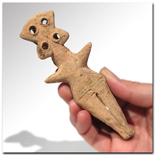 Syrio-Hittite
Venus 18-1000 BC Central and
southwest Anatolia northern Syria
Syrio-Hittite
Venus 18-1000 BC Central and
southwest Anatolia northern SyriaThe goddess Astarte is much like the contemporary Venus we see on Cyprus. Large holes apparently for ring decoration (referred to as being "pegged"), palm sized with stubby arms are a common style among other cultures too. The pinched face is found on the stubby armed figurines as well as the pillar shaped statuettes.
 Minoan
Snake Goddess 1600 BC Crete Mediterranean
Aegean (Gimbutas: Old Europe)
Minoan
Snake Goddess 1600 BC Crete Mediterranean
Aegean (Gimbutas: Old Europe)These and others like her were plentiful when the mother cult was popular. This is the only Venus figure that I have seen that includes the snake. The snake is one of those pervasive symbols from the Paleolithic and onwards which has the two meanings of good and evil. Depending on context the good aspect is one of wisdom and you find the serpent wrapped around the caduceus which I believe is emblematic of the scepter which is associated with Inanna. This could be the closest Venus to the Garden itself.
 Canaanite 1400 BC
Ugarit/Phoenicia very
northwestern Syria and coastal Levant
Canaanite 1400 BC
Ugarit/Phoenicia very
northwestern Syria and coastal LevantThese figurines are called pillar figurines for the obvious reason. Symbolism may be connected to the Tree of Life as in the cosmic pillar (not my idea). These are examples of Asherah the Canaanite Venus, the Goddess of the Sea and the Mother of all the Gods.
 Cyprus 1450 - 1200
BC. East Mediterranean
Sea
Cyprus 1450 - 1200
BC. East Mediterranean
SeaThese Venus figurines have ceramic earrings and their ear perforations are found in the C-T culture and in goddess idols all the way east to Turkmenistan.

 To
the left. Romania-Moldova-Ukraine C-T
culture 5500 - 2750 BC.
To
the left. Romania-Moldova-Ukraine C-T
culture 5500 - 2750 BC.This figure has the same pinched face and holes to each side of the head. The heavy line work about the body is typical of artwork from this culture. Some archaeologists think that these deeply grooved lines represent tattoos or scarring rather than clothing. That could very easily be the case. The Andites were traders and had made contact via the Silk Road through Turkmenistan with the Chinese. They could be the blond and redhead Caucasoid mummies of the Tarim Basin that has confounded archaeologists and historians alike. Some of these mummies are well perserved and display a number of tattoos and the earliest mummies date back to about 1800 BC. There has been the observation of the similarity of Ötzi the Iceman to some of the tattoos of the mummies. Ötzi lived about 3300 BC and was found near the border of Austria and Italy. Also associated with these mummies are the brightly colored tartan textiles which we today consider as Scottish and Irish. We also consider the Irish as Celtic. Archaeological evidence points to the Celts as being originally from this general area of the Cucuteni-Trypillian culture but their influence was much larger, a subject too involved to discuss here. Lastly this C-T area is in line of westward Andite migration through the northern Caspian corridor and the Caspian Sea itself to Europe both by land and by the Danube. This seems to correlate with what the Urantia Book has to say about Andite migration.
The Styles
Below are the Venus styles over a long range of time

The
second oldest
figurines are the painted red ochre ones shown above from the Gravettian
Period, the oldest being Aurignacian which I discuss only very briefly
here. The Aurignacian culture covers the greatest extent of land and
the oldest
figurines are considered as "humanoid objects." Much contested the
very oldest which are debated by some as not being a human figure.
Other figures include
animal and mystical figures, those anthropomorphic statuettes most
likely shamanistic of half human and half animal. These Gravettian
figurines are more detailed and display the classic signature of
voluptuousness more so than the more abstract ones we see later. Many
archaeologists believe that the tapering off of the legs and feet are
for the purpose of sticking the figures upright in the earth. I hardly
believe that. Rather the shape has more to do with being hand held than
a way to be displayed. There are many figures with no
feet and some with legs that do not taper to a point. Only the
elements necessary to mark them as a goddess or Venus are evident. The
various styles seem to suggest a movement and settlement of people.
Historians however point out that style alone does not
indicate a movement and resettlement of people. You need other
components such as architecture, burial practices and religious beliefs.Below are the Venus styles over a long range of time



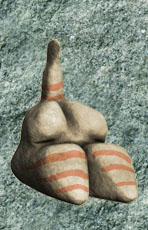
The Neolithic spawned such a variety of styles incorporating the old with the new. That seems appropriate. New forms such as the pillar figures, the flat plank figures and forms so minimal they are hardly recognizable arose during this time. Such a creative scale. Some archaeologists such as Marija Gimbutas break down regional goddess figures into further symbolic groups. One way to get a perspective is to subset the categories:
 Realistic.
As the title suggests there is no disagreement as to what you are
looking at. This statuette has been labeled by different historians as
Inanna, Ishtar and Astarte and they would be correct despite origin,
for Inanna was Ishtar of the Babylonians and Astarte of the Assyrians.
And she was so much more.
Realistic.
As the title suggests there is no disagreement as to what you are
looking at. This statuette has been labeled by different historians as
Inanna, Ishtar and Astarte and they would be correct despite origin,
for Inanna was Ishtar of the Babylonians and Astarte of the Assyrians.
And she was so much more. Ringed
Ear.
In a striking Dumbo-like appearance the oversized ear was pierced for
housing large ceramic earrings. The face was pinched in the Syro-Halaf
style called by some bird-like. This style circles around the Black and
Caspian Seas like one large loop.
Ringed
Ear.
In a striking Dumbo-like appearance the oversized ear was pierced for
housing large ceramic earrings. The face was pinched in the Syro-Halaf
style called by some bird-like. This style circles around the Black and
Caspian Seas like one large loop.
Some
of these figurines have smaller holes than the Cyprus and Syrian idols.
Sometimes there are many perforations. These holes seem to suggest a
symbolism not yet understood and may in some cases be a stand alone
feature as they are too small for a ceramic ring. It is not uncommon to
see a small puncture at the sides of the hip, at the breast area or in
other locations about the body (see map above: Syrian figurine). In the
end it could be simply be
decorative as in the practice of indicating textiles by scribing lines
but I think there is more to it but what that could be is a mystery. I
do have one theory. On my page Shamanism
and Revealed Religion
there is a quote from the UB about sacrifice, "Men were circumcised;
women had their ears pierced." Sacrifice was a huge part of religious
culture. It was everywhere. Considering the magnitude that early people
put on sacrifice I find it no large leap to that concept as applied to
these particular figurines. If you think that this is a small thing
then consider that this partial mutilation was an advanced practice
that replaced complete human sacrifice.
 Plank.
These
figures are flat as a board. Usually with a tiny pinched face and
sometimes minuscule breasts which this image has. Almost all have some
kind of inscribed line work and or punctures indicating textiles. They
can also be devoid of any decoration reducing them to the most minimum
figure possible. When this type of figure has breasts they are
unusually
high at the shoulders. Most are from Cyprus, labeled as Red Polished
Ware and usually
found in tombs. The Greek Boeotian version includes a flat pedestal.
The
Cucuteni plank figurines are deeply etched much like their more three
dimensional statuettes. I find all of them very appealing.
Plank.
These
figures are flat as a board. Usually with a tiny pinched face and
sometimes minuscule breasts which this image has. Almost all have some
kind of inscribed line work and or punctures indicating textiles. They
can also be devoid of any decoration reducing them to the most minimum
figure possible. When this type of figure has breasts they are
unusually
high at the shoulders. Most are from Cyprus, labeled as Red Polished
Ware and usually
found in tombs. The Greek Boeotian version includes a flat pedestal.
The
Cucuteni plank figurines are deeply etched much like their more three
dimensional statuettes. I find all of them very appealing.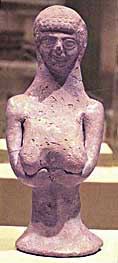 Pillar. This
one is Asherah sometimes called Astarte or Ashtart which is the same
goddess but
different cultures. This one is Canaanite which is similar to the
Assyrian and Phoenician. The Hebrew name is Ashtoret. It is not at all
unusual to see mislabled goddesses given the closeness in names and
styles. This
pillar style can be found on Crete, the
Cycladic islands and all the way to the Indus Valley.
Pillar. This
one is Asherah sometimes called Astarte or Ashtart which is the same
goddess but
different cultures. This one is Canaanite which is similar to the
Assyrian and Phoenician. The Hebrew name is Ashtoret. It is not at all
unusual to see mislabled goddesses given the closeness in names and
styles. This
pillar style can be found on Crete, the
Cycladic islands and all the way to the Indus Valley. Nebra.
My term for this category because it is the easiest to remember. These
are highly stylized and are comparable to the unadorned plank
figurines. It is the Venus in her essential form with only the buttocks
and torso and a few examples with the inclusion of breasts. The shape
is to a certain extent a result of the material it was carved from
which in this case is reindeer antler.
Nebra.
My term for this category because it is the easiest to remember. These
are highly stylized and are comparable to the unadorned plank
figurines. It is the Venus in her essential form with only the buttocks
and torso and a few examples with the inclusion of breasts. The shape
is to a certain extent a result of the material it was carved from
which in this case is reindeer antler. Stubby
Arms.
That's
my name for this style. The Venus to the left is from Turkmenistan and
is a variant of the plank figure with detailed hair and unusually large
breasts (for a plank figure) much like those in the Indus Valley to the
south. The pubic area
is bent
to form a base of support.
Stubby
Arms.
That's
my name for this style. The Venus to the left is from Turkmenistan and
is a variant of the plank figure with detailed hair and unusually large
breasts (for a plank figure) much like those in the Indus Valley to the
south. The pubic area
is bent
to form a base of support.
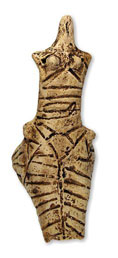
 Many
plank figures also have stubby arms along with their more three
dimensional
forms. These three smaller figures are from L to R, Indus Valley,
Cucuteni-Trypillia and the Greek Boeotian style from about 550-500 BC
which is relatively late on this time scale.
Many
plank figures also have stubby arms along with their more three
dimensional
forms. These three smaller figures are from L to R, Indus Valley,
Cucuteni-Trypillia and the Greek Boeotian style from about 550-500 BC
which is relatively late on this time scale.
 Sitting.
This may
not even seem as a category but it is mentioned as one here because of
the meaning of the pose. Archaeologists only mention it as sitting but
are unaware of why she is sitting. It is a small but important point
because of what the Sumerian stories say about their favorite goddess
and that is one of being the king maker who grants both political and
religious authority. Inanna as the Queen of Heaven sits upon her throne
and thus the pose. Early man could have simply carved her as a standing
form, which he did, but there is a variety in this sitting pose that
exhibits an underlying understanding of what the figurine in all its
symbolism represents. Sometimes, like the figure to the left, she is
completely sitting as in
this example from Tell Sarab Tappeh in Iran. Others are half bent and a
number of them are bent at the knee. Nothing in ancient art is without
meaning and these early artists had to pack a lot of meaning into these
figurines. The Nebra figures show that much was understood and
indicating a foundation of beliefs without the need of additional
detail. Later such as the seated goddess of Çatalhöyük
has a throne
replete with lion heads one of the animals directly connected to
Inanna. Those from the C-T culture have her on a spoon like stand-in
throne, very
simple but effective as shown above. A number of cultures have the
goddess bent
partially at the waist. Not quite sitting and not quite standing but a
posture to indicate a subtle association with the throne. So we can see
when
the Venus is understood in light of the Sumerian texts a much broader
symbolism is revealed. The archaeological fertility goddess is much
more than that. She is if anything more of a sacred figure than one of
fertility. This is supported by the fact that most of these figurines
are found in graves and in temples. Therefore what seems to be a rather
small detail, a sitting figure, is heavily weighted with religious
symbolism and
political might.
Sitting.
This may
not even seem as a category but it is mentioned as one here because of
the meaning of the pose. Archaeologists only mention it as sitting but
are unaware of why she is sitting. It is a small but important point
because of what the Sumerian stories say about their favorite goddess
and that is one of being the king maker who grants both political and
religious authority. Inanna as the Queen of Heaven sits upon her throne
and thus the pose. Early man could have simply carved her as a standing
form, which he did, but there is a variety in this sitting pose that
exhibits an underlying understanding of what the figurine in all its
symbolism represents. Sometimes, like the figure to the left, she is
completely sitting as in
this example from Tell Sarab Tappeh in Iran. Others are half bent and a
number of them are bent at the knee. Nothing in ancient art is without
meaning and these early artists had to pack a lot of meaning into these
figurines. The Nebra figures show that much was understood and
indicating a foundation of beliefs without the need of additional
detail. Later such as the seated goddess of Çatalhöyük
has a throne
replete with lion heads one of the animals directly connected to
Inanna. Those from the C-T culture have her on a spoon like stand-in
throne, very
simple but effective as shown above. A number of cultures have the
goddess bent
partially at the waist. Not quite sitting and not quite standing but a
posture to indicate a subtle association with the throne. So we can see
when
the Venus is understood in light of the Sumerian texts a much broader
symbolism is revealed. The archaeological fertility goddess is much
more than that. She is if anything more of a sacred figure than one of
fertility. This is supported by the fact that most of these figurines
are found in graves and in temples. Therefore what seems to be a rather
small detail, a sitting figure, is heavily weighted with religious
symbolism and
political might.
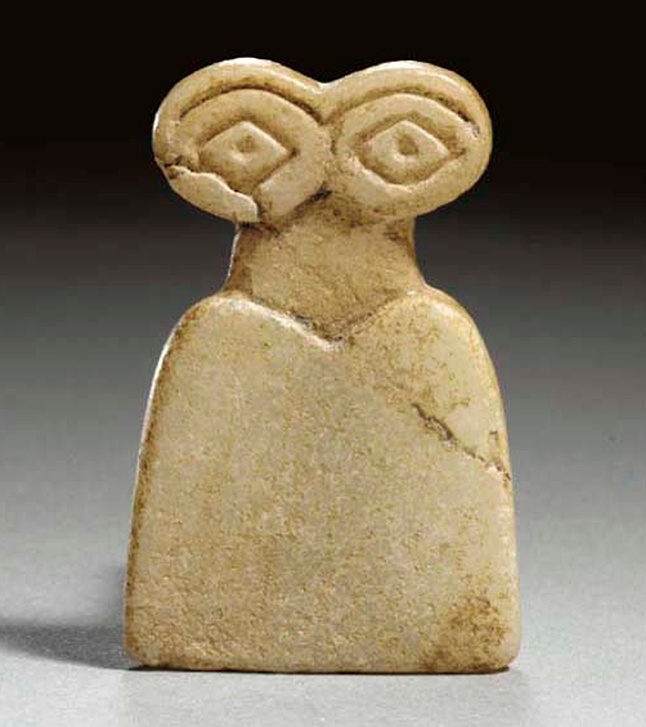 Eye Idol. These
are not considered as a Venus figure but shown here as an example of
another
important comparison of the Venus figurine, not as a fertility figure
but as
a religious artifact. These to the left originate from northern Syria at Tell Brak,
with an enormous focus on the eyes. They date to about
3200 BC and there are no other examples of this style of religious art
in Mesopotamia.
Thousands of these figurines were found at Tell Brak mainly in the "eye
temple" and come in a
number of presentations. Some are doubled headed, some have a smaller
child-like figure etched in front and others have multiple eyes. Most
have a wavy line motif perhaps indicating clothing. Some have a bell
shape body and others are flat like the plank figures. The figure to
the far left is known as a spectacle eye idol because the eyes are
completely drilled through. These are not the only intriguing eye
figurines. See the following:
Eye Idol. These
are not considered as a Venus figure but shown here as an example of
another
important comparison of the Venus figurine, not as a fertility figure
but as
a religious artifact. These to the left originate from northern Syria at Tell Brak,
with an enormous focus on the eyes. They date to about
3200 BC and there are no other examples of this style of religious art
in Mesopotamia.
Thousands of these figurines were found at Tell Brak mainly in the "eye
temple" and come in a
number of presentations. Some are doubled headed, some have a smaller
child-like figure etched in front and others have multiple eyes. Most
have a wavy line motif perhaps indicating clothing. Some have a bell
shape body and others are flat like the plank figures. The figure to
the far left is known as a spectacle eye idol because the eyes are
completely drilled through. These are not the only intriguing eye
figurines. See the following:


 These similar
figurine objects are found in different locations. The first
is
from Spain called an Idolo-Oculado. Variants on this theme do not
widely differ. Next is a stone figure from Valdivia Ecuador around
3500-2000 BC. These do not vary greatly in style either. The next two
are made from metal and documented as coming from Persia and Anatolia
respectively. No dates given. The last couple are made of bone. They
come from Stara Zagora, Bulgaria, 5000-4000 BC. The figures
from
the Stara Zagora sites come in a range of styles and their numerous
styles are an indicator
of a crossroad of
cultures. The river Danube is Bulgaria's northern border.
These similar
figurine objects are found in different locations. The first
is
from Spain called an Idolo-Oculado. Variants on this theme do not
widely differ. Next is a stone figure from Valdivia Ecuador around
3500-2000 BC. These do not vary greatly in style either. The next two
are made from metal and documented as coming from Persia and Anatolia
respectively. No dates given. The last couple are made of bone. They
come from Stara Zagora, Bulgaria, 5000-4000 BC. The figures
from
the Stara Zagora sites come in a range of styles and their numerous
styles are an indicator
of a crossroad of
cultures. The river Danube is Bulgaria's northern border.Conclusion:
Judging from the break between the Gravettian and the Magdalénien, which is about 5000 years, something was established in the minds of these early people. The conceptual jump from realistic to radical abstract demonstrates that the artists who were making these figurines felt comfortable enough to create these new forms and that this very different approach was recognizable and accepted by the tribes and clans of the time. That's huge because of its implications. It may indicate of just how tenacious and wide spread the belief and worship of the Great Mother had become. It is not just Andites who you would expect would be aware of the meanings of these changes but you have the Nodite tribes and the indigenous such as various Andonite, Sangik and mixed tribes who must have had a full understanding. If not, there would have been at least a mix of the more representative with these abstract figures but that is not what the archaeological record shows. To put this in some kind of context we are talking of a time about 17000 years ago, Old Stone Age, a time when some people were living as the proverbial cave man. The Andites by this time had become numerous enough as to constitute a race of men from over the past 10000 years and their beginning reaches back to about the time of the beginning of the Gravettian one of representational art. Contrast that with the arrival of Magdalénien with its Venus figurines with no head, no feet, no arms and amazingly no breasts or vulva with only the barest suggestion of a torso and hip. This was the new Venus. And that means a figure bereft of sexuality was still imbued with all the trapping of fecundity and, or more importantly, sacredness. The Cycladic figurines of the Bronze Age also lack breasts and are not considered as male. Therefore the idea that the goddess represents only sexuality is not borne out by the archaeological record. If anything it is the religious aspect that is the most important. So, a quantum leap was made conceptually, that such a very simple shape could express such cultural complexities. Later we see a return to more detail and some of it a continuation from these Nebra-like figures. Most telling are the elongated necks and torsos. Some do reflect the older tradition of minimalism like the plank and violin figures. The old was being rolled into new expressions of the goddess. But the more she changed the more she remained the same.
Thank you for reading.
 Introduction
Introduction Enoch
Enoch